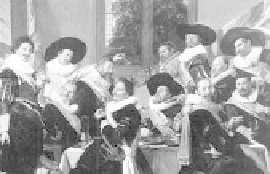Travel Reference
In-Depth Information
Civic guard portraits
The fathers of the men pictured in this room fought, suffered
imprisonment, and died in the great Siege of Haarlem (1572-
1573), which helped turn the tide against Spanish oppression.
But their sons were bankers, merchants, traders, and sailors,
boldly conquering Europe on the new frontier of capitalism.
Civic Guards became less of a militia and more a social club
for upwardly mobile men. Their feasts—huge eating and
drinking binges, punctuated by endless toasts, poems, skits,
readings, dirty limericks, and ceremonial courses—could last
for days on end.
Standard Civic Guard portraits (see page 78 of Amster-
dam City Walk) always showed the soldiers in the same
way—two neat rows of men, with everyone looking straight
out, holding medieval weapons that tell us their ranks. It took
master artists like Hals and Rembrandt to turn these boring
visual documents into art.
flag marking the right diago-
nal (echoed by several tilted
ruffs), and a slanting row of
heads forming the left diago-
nal (echoed by several slanting
sashes). The diagonals meet at
the back of the table, marking
the center of the composition,
where the two groups of men exchange food, drink, and meaning-
ful eye contact.
Meeting of the Officers and Subalterns of the Civic Guard
of St. Adrian
(1633)
Six years later, Hals painted many of
these same men gathered around an out-
door table. The horizontal row of faces
is punctuated by three men standing
sideways, elbows out. Again, the men are
united by sashes that slant in (generally)
the same direction and by repeated ges-
tures—hands on hips, hands on hearts,
and so on.
Officers and Subalterns of the St. George Civic Guard
(1639)
When 57-year-old Frans Hals painted this, his last Civic Guard
portrait, he included himself among his St. George buddies. (Find




















